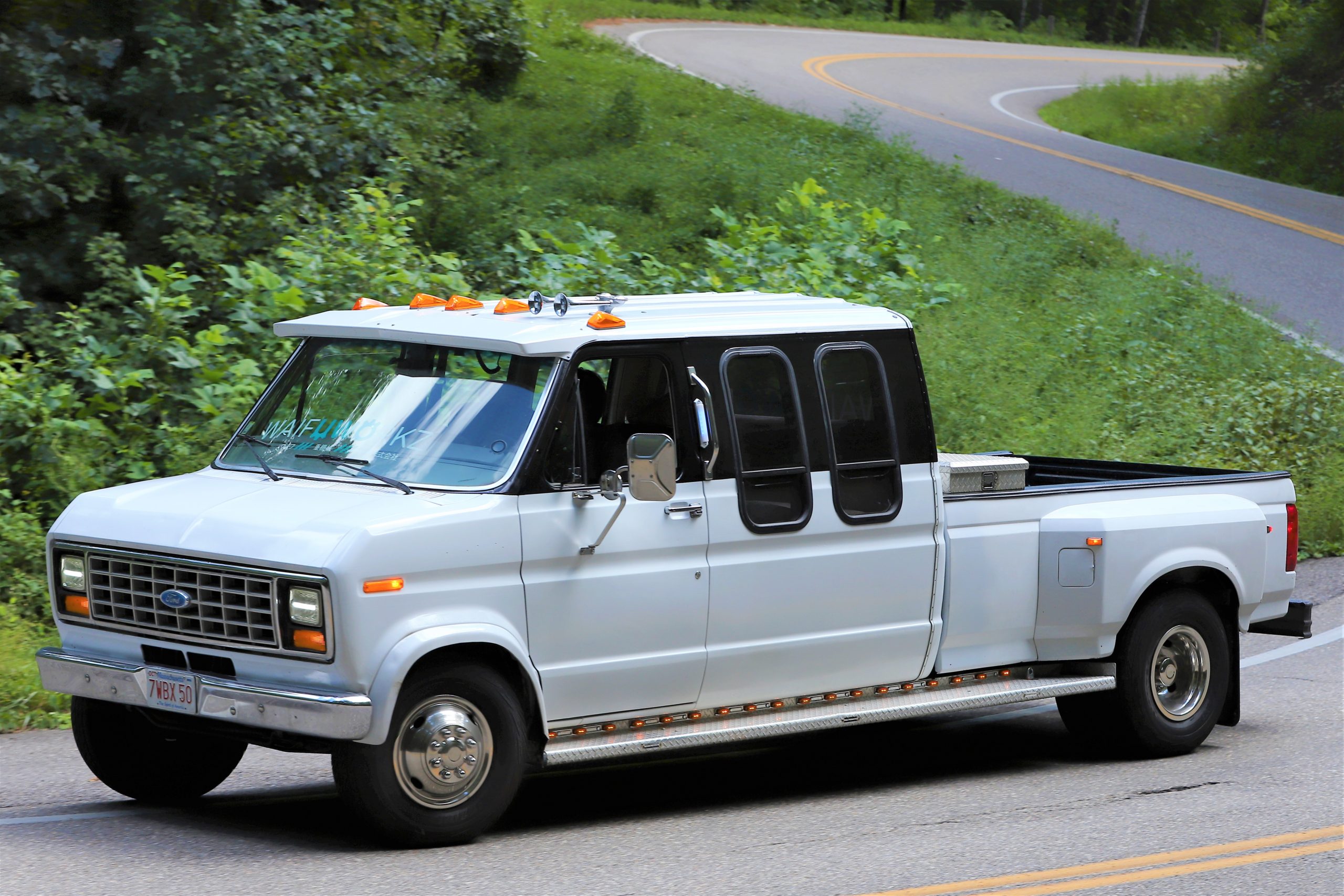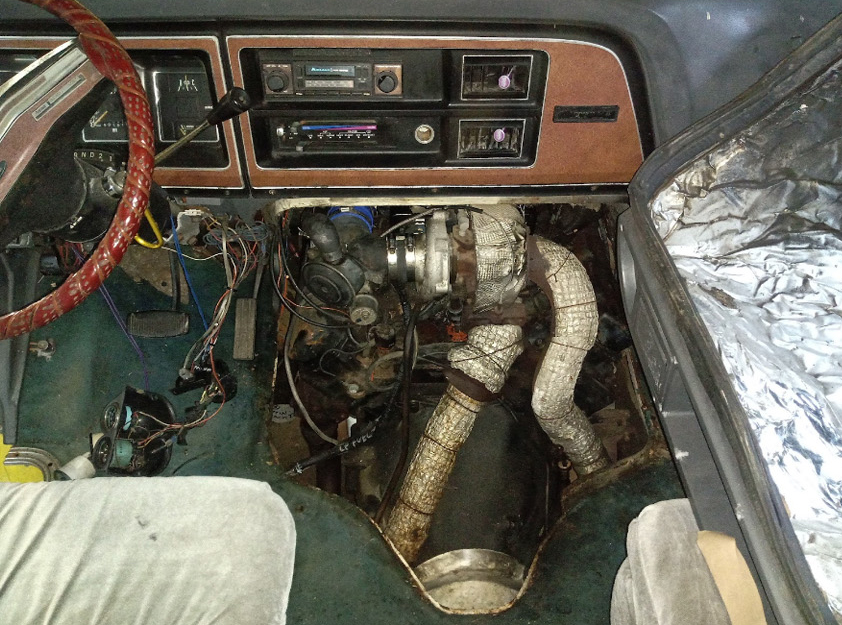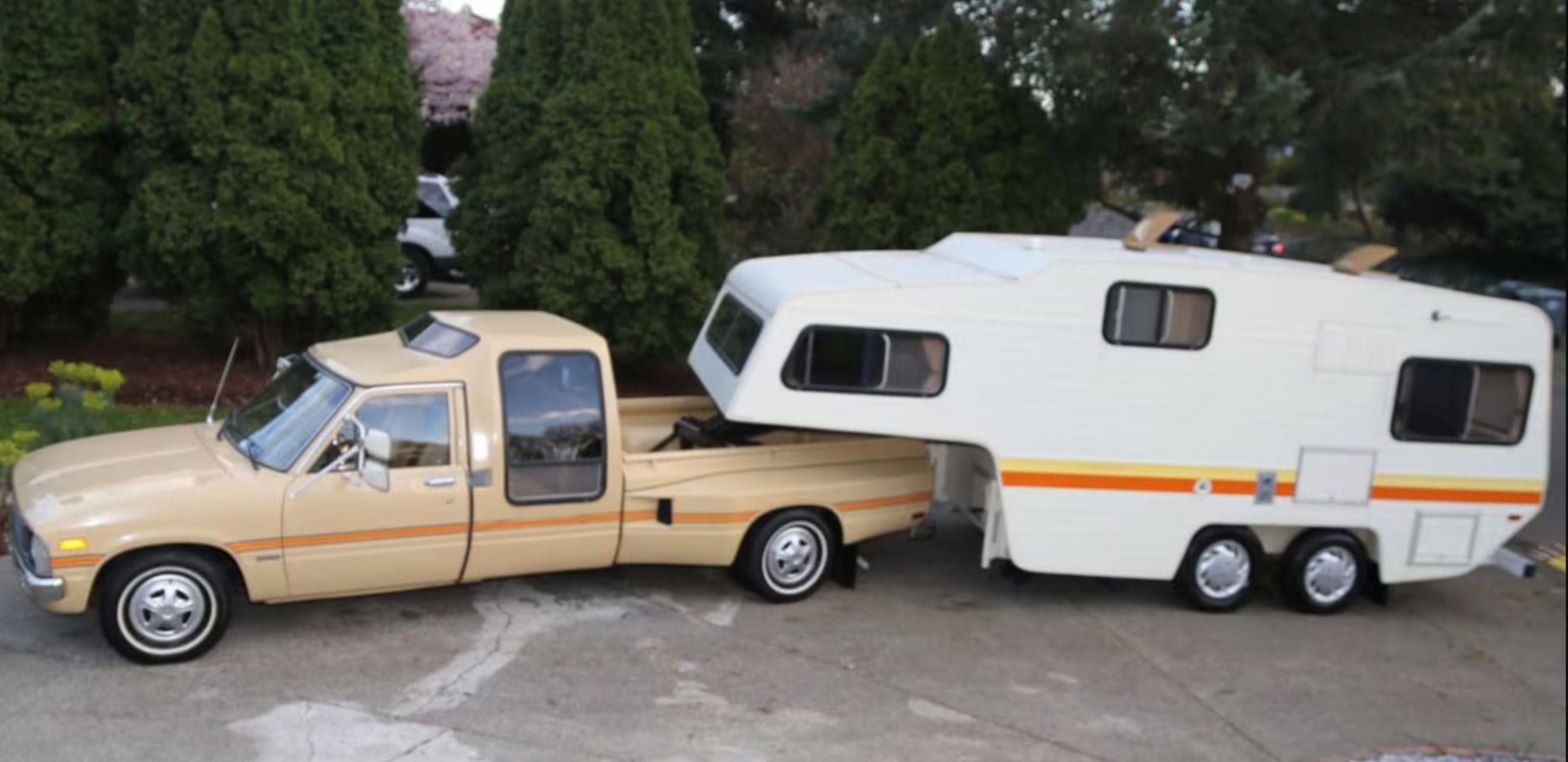Most of my car-scribbling time is devoted to vehicles a large percentage of people might want to purchase, and while “take my money now” and “10/10 would buy” are nice things to hear, I have a lot more fun when my design time is unrestrained by considerations of what the masses might need or want.
It’s far more amusing to create niche vehicles that a very small segment of buyers will find useful, like the subject I’m turning my attention to today. Forget buyers, plural; this machine might attract just one buyer, perhaps a certain MIT engineering graduate (once it’s a used-up mess, of course).
I’m talking the dedicated fifth-wheel tow vehicle, a category that represents some of the strangest concoctions ever dreamed up by aftermarket auto manufacturers.

Contributor and BattleBots maker Charles Guan has collected several of these diesel-powered van-based fifth-wheel rigs, seemingly for no other reason than the fact that they’re strange and that it likely qualifies him for Autopian sainthood when he is eventually done in by shrapnel when one of his homegrown turbos finally explodes. I mean, look at that image below: is the tin foil and plastic Ford engine cover really going to protect him from the equivalent of a land mine?

Fifth-wheels look even stranger viewed from the rear. Also, they really needed more running board lights:

Note that Charles appears to be running these things on the Tail of the Dragon, the last place on earth it should go and the last vehicle you’d want to drive there.

How could I make a vehicle that would entice someone like Charles to buy it? What if it were just as bizarre as his current rides, yet offer far more capability? Oh, and what if it could possibly have the ability to break a fifth-wheel towing world record? No, really.
“Centaur” Might Have Been A More Appropriate Name
As strange as the automotive trends of the late seventies and early eighties were, they became even more bizarre when they cross-pollinated and spawned odd Reese’s Peanut Butter Cup mashups. The popularity of curtains-and-crushed-velour-captains-chairs conversion vans coincided with the rise in sales of fifth-wheel RVs, so maybe it was only natural that some companies would create an unholy alliance that combined the two. Few are the same, but the general formula was to chop a Ford Econoline van somewhere in the middle, keeping a passenger or sleeping space but stretching the frame to allow for a pickup-like bed with a custom fifth-wheel hitch setup. Possibly the most prolific were the Centurian E-350 and the oddly named Cabriolet.

The Cabriolet goes all-out with a raised roof for extra headroom and also to form a spoiler to divert air over whatever you’ve got hitched up back there. Nice semi-style exhaust stacks! That accent on the “e” in “Cabriolet” is especially classy.

As strange as these things seem, they do seem to make sense in some ways since the Econolines have tremendous passenger space and are available with some mighty motors. What doesn’t make sense to me are somewhat similar products from the era that use Toyota pickups as a basis. The Sunrader Dually took the same idea of the Cabriolet by stretching the frame of an existing truck, adding a special raised passenger compartment and bed with flared fenders to cover the extra wheels in back. This one below came up for sale a little while back:

Admittedly, the trailer that this thing is towing is smaller than a typical fifth wheel (I believe this is a 21-footer, while most popular ones such as Jaycos start at 24), but regardless of that, one must wonder about the, um, motivation. The standard Toyota 22R 2400cc four is a great motor in something like the ’81 Celica my aunt had, but somehow 97 horsepower and 128 lb-ft of torque seems a bit marginal for towing a small house.

If nothing else, the Toyota shows us that there are many different ways to drag a fifth-wheel camper down the road. Or down the salt flats at 120 miles an hour. Let me explain.
Tow Jamming: Breaking The Record
As I’ve mentioned before, there are official world records for everything, including very bizarre ones. Automotive records in particular make you wonder how people even thought of the idea of trying to set them. Driving backwards in a Chevy Blazer for 37 days and 9,031 miles? How about going in reverse at 171 miles an hour? It’s been done, so it should come as no surprise that there have been a number of attempts over the decades for the fastest towing speed of a camper trailer.
In 1980, a British firm wanted to use a top speed record to showcase their aerodynamic new Autosport Alpha caravan (as they’re called in the UK) with a top speed record. With a curved front window, it was indeed a rather slick-looking piece for the time.

The Capri in that brochure photo likely wouldn’t have the power needed to achieve a record velocity, so Autosport employed a LeMans-winning Aston Martin DBS V8 called the “Muncher” to do the job.
Official top speed attained was 124 miles an hour due to the rain (because of course it was raining in Britain) and you can see a picture of the effort by clicking here. Additional attempts with the bizarre rig yielded much higher velocities (well over 150) but the speed was not sustained, and ultimately the giant front window of the Alpha camper blew out and reportedly decimated the whole camper.
The current record holder for camper towing has stood since August 23, 2012. A standard Carson Kalispell trailer was towed by a modified GMC 2500HD at El Mirage Dry Lake, California. Pacific Performance Engineering added a turbo intercooler as well as new exhaust and a two-stage nitrous system to get the 6.6 Duramax up to reportedly over 1000 horsepower before the NOS kicked in to top out at an official 141.998 MPH.
What’s most interesting to me is that physically the truck and trailer appear to be bone-stock; neither of them has been optimized for any kind of aerodynamic efficiency. This rig looks absolutely nothing like the race car and streamlined caravan combination that once held the record (and you would assume might be the template for such a feat).
Also, you’ll notice that it’s a standard trailer setup and not a fifth-wheel system. Exactly what the speed record for towing a fifth-wheel camper is is not something that I could find. In fact, our own RV guru Mercedes Streeter was unable to source such a record either. This doesn’t mean that such a feat has not been attempted, or that a speed record hasn’t been established, or even that the parameters for what constitutes a “fifth wheel tow top speed” haven’t been set. What it does mean is that I smell a challenge.
Taking The Fifth- The Ultimate Tow Vehicle
Unlike that nearly-142 MPH GMC pickup or Charles’s van contraptions, I’d like a tow vehicle and possible record establisher to be low to the ground for better handling and far better aero; plus, you might not need 1000 horsepower if your vehicle has a frontal area less than a house. As a tow vehicle, we pretty much need a body-on-frame car that can accept a big American V8. This leaves essentially two choices for us: a full-sized 1977-96 GM “B” body or a 1979-2012 Ford “Panther” chassis.


The later “aero” versions of these (“whale wagons”) might be the best route, but for shits and grins I decided to use an old Buick station wagon with the 1977-90 body as a basis. Maybe I’m still inspired by this 328 horsepower turbo V6 mockup that Buick built back in the eighties that could get to 60 in the five-second range and cornered flat as a pancake for a land yacht (I’ve set the video to start just before the wagon):
The chassis would be stretched and a dual rear wheel axle added; to keep the length as short as possible there would be limited overhang off the back. A removeable, enclosed cargo bin might live in the “bed” space next to the fifth-wheel hitch.

I could see removing the hitch and offering a slide-out or add-on pickup bed to allow you to carry cargo if you felt like it, giving this tow vehicle even more usefulness.
Inside, the cabin has been stretched with a section that rises up to form a spoiler that directs wind over your trailer; we might even add another adjustable spoiler on top to help. Skylights and big windows let in light on a rear seat that can slide way back to give immense legroom. I’d put a power-adjustable front bench back there on sliding rails so it could theoretically be turned into a bed-like sleeping space (I added a set of power control identical to the front on each rear armrest). It looks so luxurious that this thing could be a limo, though, admittedly, the last thing your daughter would want to be taken to prom in.

Let’s start with the original wagon:

The Buick’s nose would be replaced by a pointed fiberglass piece holding smaller (LeBaron sourced) composite headlights for better aerodynamics and a unique look, with an air dam below. Body-colored chrome bumpers and badass GNX-like wheels finish off the look (we’d need spacers in back to allow fastening to the inner tires of the “dually” setup).

Now, some might say that a tow vehicle needs to be like one of the vans that Charles owns with giant front hubs and eight-lug wheels in order to accomplish the task at hand, but I say no. Those GM B-bodies (and, to be fair, Ford Panthers) will take a lot of abuse, and there is no need to overbuild a competition machine. Honestly, as Colin Chapman reportedly said, the best race car will fall apart after crossing the finish line (though some say he applied the same logic to his street cars).
What’s under the hood? Who cares? There are plenty of options you could choose from since the B-body was offered with engines as big as the 403 cubic inch Olds V8 at the beginning of the run (and rather quickly discontinued). That means there is ample room for big, dirty power that we can easily get. What do we need? A thousand horsepower? Twelve hundred? Whatever it takes to set a record towing speed that will be high enough to stand for years. I mean, if there’s anything more important than the speed record for fifth-wheel camper towing, I can’t offhand think of what that might be. Are you going to do the driving, Mercedes Streeter? I think you own a helmet.
Some Ask “Why,” We Ask “Why Not?”
Charles Guan says, “(Fifth wheel haulers) have very niche popularity. Surprising, given that they’re perfect. Now we now know Charles isn’t wrong; we just hadn’t seen the perfect fifth-wheel towing machine. That’s where the bizarre vehicle above comes into play. Insane power, handling of a (semi-clapped out) cop car, a versatile cargo bed, ride comfort like a cloud, and “unique” low-profile styling would make our world record attempt Buick wagon-based tow mobile the kind of machine to gain the respect of nearly dozens of car enthusiasts everywhere. That’s the Autopian dream if I ever saw it.
Would You Sleep In An RV Made Out Of A Hearse? – The Autopian
How Our Daydreaming Designer Would Turn A Scion xB Into A Delightful Camper – The Autopian
A Daydreaming Designer Imagines If Airstream Made An Actual Car In The Seventies – The Autopian
How Our Daydreaming Designer Would Turn An Old Mail Truck Into An Amazing Mini Camper – The Autopian







Could you achieve the same thing with an El Camino and less bodywork?
The aero vault is the most aerodynamic trailer I can think of.
It’s not a fifth wheel, but you could add a gooseneck to the front.
I think the factory has made low drag tow vehicles for these.
I’ve seen some.
https://aerovault.com/
Re the turbo van, they make ballistic covers for the shrapnel issue.
And any performance use should have a captive drive shaft to prevent it poking into the ground and causing an involuntary conversion at speed.
That can be done inexpensively.
If you’re not already planning for it, the trailer needs a torsion suspension or better.
I reckon a G63 6×6 pickup would be your best bet
You could use the Factory Five pickup.
For better aero, a modified version of their Daytona possibly?
I think they have run a Daytona for top speed already.
There are semi tractors that make speed runs.
They seem likely to be amused by the idea.
I can’t tell you if any are currently equipped for towing.
This is the project the 8 wheel KAZ electric minivan was born for!!
Upgrade it with more modern motors – It has the size and shape to punch a big clean hole in the air ahead of the trailer, and the power and traction to pull it to truly crazy speeds.